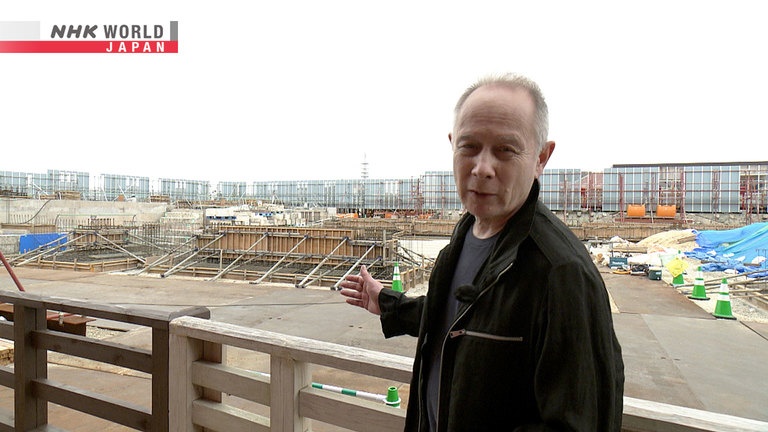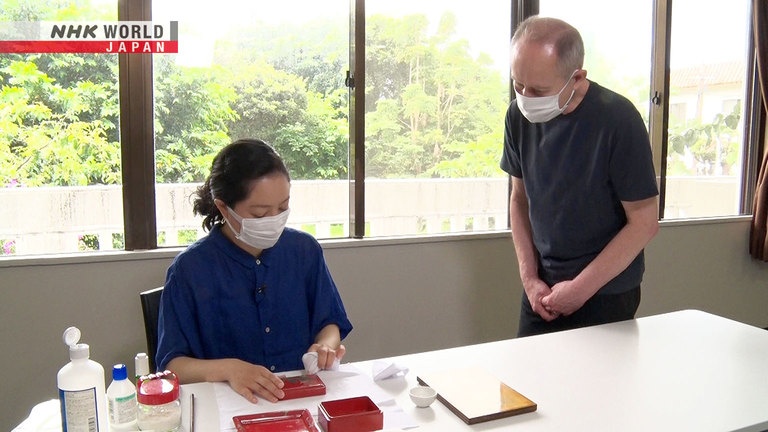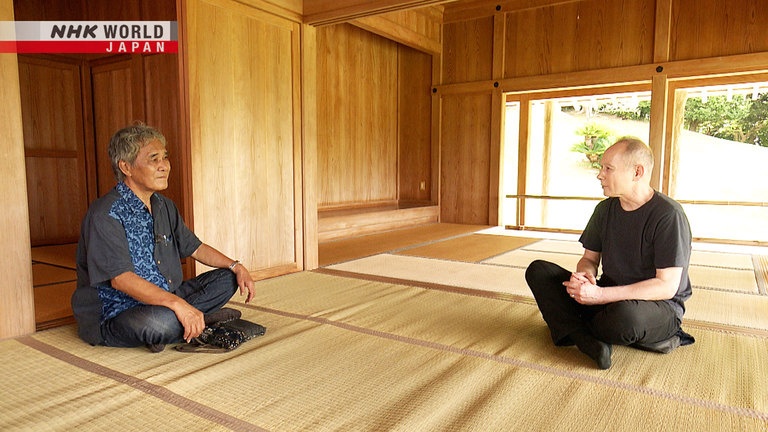Okinawa: The Reconstruction of Shuri Castle
*First broadcast on July 21, 2022.
Okinawa Prefecture is a group of subtropical islands in the far south of Japan. It was previously a prosperous maritime trading state called the Ryukyu Kingdom. In the second of 2 episodes about Okinawa, we focus on the kingdom's political and cultural hub: Shuri Castle. Our guest, historian Takara Kurayoshi, talks about working on the castle's reconstruction, and shares how he felt in 2019, when a devastating fire burned it to the ground. He also tells us about the forthcoming reconstruction project.



Transcript
Hello, and welcome to Japanology Plus.
I'm Peter Barakan.
This is the second of two episodes about
Okinawa, Japan's southernmost prefecture.
Our topic for today is Shuri Castle,
which played a central political and
cultural role in the Ryukyu Kingdom,
which is how these islands were known
before Okinawa became a part of Japan.
Having been obliterated once
during the battle for Okinawa
towards the end of World War 2,
the castle was then rebuilt, and went
on to become a major tourist attraction.
But then, in 2019,
a terrible fire broke out.
Magnificent wooden buildings
used to stand right back here.
As you can see, there's absolutely
no trace of them now,
although reconstruction work
is due to start shortly.
Between the 15th and 19th centuries,
Shuri Castle served as the royal
palace of the Ryukyu Kingdom.
It was bright red,
very unlike the black and white of so many
castles found in Japan in those days.
Various structures surrounded a courtyard.
The largest was the Seiden,
the central building.
This three-story wooden structure
represented the pinnacle
of Ryukyu architecture.
Shuri Castle was known for
blending Chinese and Japanese influences
with an authentic Ryukyu appeal.
And the Seiden clearly
showcased those characteristics.
The curved roof at the front, for example,
was common in Japanese architecture.
The dragon carvings and
colorful decorations, meanwhile,
were inspired by China.
Political discussions and official
ceremonies were held inside.
Here, too, the color red
features prominently.
Most spectacular of
all was the throne room,
which could only be accessed
by the royal family, and a few others.
It was built and decorated by
skilled artisans of the Ryukyu Kingdom.
The Seiden was a distillation of Ryukyu
architectural and artistic prowess.
It came to represent the kingdom itself.
However, on the 31st of October, 2019,
a fire broke out.
The walls of Shuri Castle made
it hard to fight the fire.
In the end, it took around
11 hours to extinguish the flames.
The fire originated in the Seiden,
which burned down completely.
Various other important
structures were lost,
and over 300 cultural assets were damaged.
The fire was devastating,
and its cause remains unclear.
The castle was a symbol of Okinawa, and
its loss hit the local population hard.
Despite the shock of the fire,
people soon took action.
There was widespread fundraising
for the castle's reconstruction.
And just two months on,
the reconstruction project got underway.
Our guest this time is
leading these efforts.
Hello, nice to meet you.
Thank you for joining us
on the program today.
Takara Kurayoshi is a historian
who specializes in the Ryukyu Kingdom.
Where were you when
the fire broke out in 2019?
I was at home, fast asleep.
Then the phone rang.
They said that Shuri Castle was on fire.
From my house,
you can actually see it in the distance.
So I checked, and I saw smoke and flames.
“Ah,” I thought.
It's really true.
I'm sure everybody must
have been devastated.
Well, many of my friends and colleagues
found it hard to believe.
And then, truly,
I don't think that the word “sadness”
even begins to cover what we felt.
At any rate, we were all shocked.
We didn't know what to say.
What about the public?
Members of the public gathered nearby,
and looked at the blaze.
On TV, they showed the crowd,
and I saw that report.
People just couldn't believe
what they were seeing.
Some younger onlookers burst into tears.
What was the cause of the fire?
Do you know?
The police and fire department
spent a long time looking into it.
They tried to discover how
the fire started, but in the end,
their official report said that a cause
couldn't be conclusively determined.
When they looked at the Seiden,
they identified a spot on the
entrance level, in the northern corner,
where some sort of electrical
fault may have caused the fire.
But it was all conjecture.
To this day, nobody knows for certain.
But it was a wooden building,
and I'm sure...
I mean, Japanese people are very thorough.
I mean, people are always
considering worst-case scenarios.
Surely there must have been some kind
of thought about “What if a fire occurs?”
Well, fire safety measures were in place.
There were smoke detectors, and so on.
But the fire broke out very late at night.
And at that time,
very few staff were on duty.
Also, it seems to have started
in a northern corner of the building.
That night, there happened
to be a very strong wind.
And it was blowing north to south.
The flames spread throughout
the wooden Seiden in mere moments.
Drenchers and other fire-related
equipment were installed,
but they could do nothing to stop it.
And here's the biggest problem.
Word of the emergency
was sent to the fire department.
But when they arrived,
they found that all the gates were locked.
And the castle is surrounded by walls.
It took a long time for
the firefighters to get in.
And when they did, it was too late.
Shuri Castle is thought to have
been built in the 14th century.
At first, it was probably
used by a local leader.
Then, when the Ryukyu Kingdom
was established in the 15th century,
it became the royal palace,
and was expanded.
Fire broke out on three occasions,
but each time the damage was repaired.
From the late 19th century,
after the Ryukyu Kingdom came to an end,
the castle was used for other purposes,
including as a school, and as a shrine.
In 1945, in the closing stages
of the Second World War,
US forces landed on Okinawa.
The islands became a fierce battleground,
with tragic consequences
for the Okinawan people.
The castle, an underground military base,
and the surrounding area
were all destroyed.
When the war ended,
Okinawa fell under American control.
Rebuilding work began.
The castle site became part of the newly
established University of the Ryukyus.
In 1972, 27 years of
US control came to an end.
After a long period of
postwar reconstruction,
Okinawa was once again part of Japan.
At around the same time, the university
decided to move to a new location,
and then more people began to call
for the reconstruction of Shuri Castle.
In 1986, that project did
indeed get underway.
Our guest, Takara Kurayoshi,
was a key member of the team.
He says that the biggest challenge was
the absence of key reference documents,
which had been destroyed in the war.
Shuri Castle is symbolic
of the Ryukyu Kingdom.
It's an extremely important
piece of heritage;
its existence represents the history,
the culture,
and the identity of these islands.
That disappeared in the war,
leaving a hole in our local identity.
At first, the lack of historical records
was a source of great concern.
Takara searched high and low for
any information that might prove useful.
After six months came an
almost miraculous discovery:
a record of 18th-century repair work
on the castle's central building.
The document was in the possession of
an expert on Okinawan culture in Tokyo,
where it had escaped
damage during the war.
When I saw the title,
it was just so exciting!
This shows the front of the building.
The document contained detailed records
of the ornamentation, and the coloring.
It also had plans of interior sections
that previously had been
shrouded in mystery.
It showed the number
of pillars and their layout,
and listed the purpose of each room.
I was immediately confident
that we could do the work.
That record, from 1768,
felt like a gift from the gods.
I still think of it that way.
Thanks to that discovery,
we were able to rebuild.
In 1989, after three years of planning,
construction work began.
The central building required
more than 100 lengths of wood
measuring over eight meters.
The 1768 document also contained
information on a red hue.
This was applied to walls and pillars
in the reconstructed castle.
The details that were faithfully recreated
included a dragon motif
symbolizing the Ryukyu king.
The former throne room was also
rebuilt—in dazzling colors.
At long last, Shuri Castle was reborn.
So the main building was
completed in 1992,
20 years after Okinawa
reverted to Japanese control.
I'm sure there must have been
a real sense of achievement.
Although it took a lot of effort, I found
one aspect to be very satisfying.
Think of music, or dance.
They can survive a war,
if there are performers to share them.
But physical heritage,
like Shuri Castle, is gone forever.
The reconstructed castle was opened
to the public in 1992.
It was a physical representation
of Ryukyu culture.
The castle complex told anyone
who saw it about the kingdom
that once existed on these islands.
It was visible to all.
That made me especially happy.
In 2019, Takara saw the result
of his hard work go up in flames.
However, preparations to construct
the castle again are now moving forward.
The new project will make use of
approaches that were not adopted before.
Key themes include
authenticity and safety.
One example concerns fire safety.
This is the planning office where
the new Shuri Castle is being designed.
Sprinklers will be added
for the first time.
Previously, there were fears that
they might damage cultural properties,
but now sprinklers are seen as vital.
They'll be housed within red piping,
so they'll blend in with
the color of the Seiden's interior.
An integrated hydrant system
will also be installed.
This system is often
used in tall buildings.
It allows for water from
a fire truck or other source
to be easily moved to different
parts of the structure.
In 2019, the castle walls
hindered firefighting efforts,
and valuable cultural assets were lost.
The features being introduced
in the new design
will allow firefighting to
be carried out more smoothly.
The building materials
that will be used in the project
are currently being prepared.
One example is the wood used to
make the columns in the central building.
Okinawa Prefecture, on its own, doesn't
have enough of the right type of timber.
Last time, the timber was
brought in from nearby Taiwan.
Historical records show
that Taiwanese timber
was also used previously at Shuri Castle.
But this time,
Taiwanese timber was not available,
and so a practical decision
was made to use similar wood
from Nara Prefecture
and other locations in Japan.
New ways of thinking are also
being applied to the roof tiles.
Okinawan artisans created the tiles
used in the previous reconstruction
after much trial and error,
and those tiles did an extremely good job.
So this time,
damaged tiles recovered after the fire are
being ground up for use in the new tiles.
Also, fresh techniques, including the
introduction of a different type of clay,
will improve tile durability.
The walls, meanwhile,
may feature paint with a
new touch of historical authenticity.
The paint incorporates a rare pigment.
During the last reconstruction,
nobody was able to identify it, but
recently that information came to light.
Mixing the pigment with lacquer
produces a hue very close to the color
used in Ryukyu times.
The new Seiden is due to
be completed in 2026.
Repair work is also progressing on
the artifacts damaged in the fire.
The most common type
of item being repaired is lacquerware.
At the time of the fire,
over 200 stored objects were exposed
to extreme heat for a long time,
causing the coating to peel and crack,
and the wood itself to warp.
Let's meet someone
who is working on that lacquerware.
The only person in Okinawa
with the necessary skill to repair
culturally important
Ryukyu lacquerware is Doi Nanako.
She shows us what her work involves.
Lacquerware is carefully cleaned,
using different methods depending
on the type of dirt or blemish.
In work like this, I pay attention to
one thing in particular.
I must remove the dirt,
but not the history.
The history...what does that mean?
Well, let's say I overdid the cleaning.
Some parts would look old,
and some parts would look new.
It would lack uniformity.
Doi uses a traditional mix of wheat flour
and Japanese lacquer as an adhesive.
It's one of the many techniques
she skillfully employs.
However, you can't repair
items like this overnight.
How long does the work take?
We just have so much lacquerware to do!
Over 200 objects are awaiting repair.
Completing them all would probably
take me around 20 to 30 years.
Will you be around to see
the completion of the work?
I wonder!
Hopefully I'll just about make it.
I would like more people to know about
these wonderful historical artifacts.
If I repair them,
people will be able to see
the value of the objects for themselves.
That's my goal.
Thanks to the hard work of many people,
Shuri Castle and the artifacts it housed
are on their way to being reborn.
Are there going to be any major
differences this time from the last time?
We've discovered new documentation.
And more research has been done.
Based on that, we have to
make all sorts of improvements.
That work is ahead of us.
For example, what sort of things?
A very important research finding was made
at the time of the last reconstruction.
It became clear from old documents that
the painting of the castle was carried
out by Ryukyu lacquerware artisans.
That understanding was then applied
in the reconstruction work.
But since then, research into lacquerware
techniques has progressed.
For example,
when lacquering the walls and pillars,
what sort of undercoat should be applied,
and how should lacquer be added on top?
How many times should that be done,
and how should the pigment be mixed in?
After that, how should
the surface coating be applied?
A lot more research was done into
these detailed technical questions.
And of course,
all of that knowledge
needs to be put into practice
in the new reconstruction project.
Another improvement we can make
involves the color of the Seiden.
Last time, documents indicated
that somewhere in the north
of Okinawa was a red pigment.
But we didn't know exactly
what we were looking for.
We ran out of time, and gave up.
But on this occasion we had more time.
So we set out to identify it.
A group of young researchers
conducted a thorough investigation.
And they made a surprising discovery:
the red pigment comes from iron bacteria.
It can be found in a specific area.
So we collected it,
cultivated the bacteria,
and applied the pigment to the same wood
used in the castle's walls and pillars.
As an experiment,
we left that wood outside,
so we could see how
durable the pigment was.
If we can produce a steady supply, we'll
use the pigment in the reconstruction.
We're clearing various hurdles.
Last time, we gave up.
But this time we may be able to apply
the same coating used in Ryukyu times.
So it's going to be a much
easier job this time around?
Well, an issue this time is
a lack of specialist artisans.
In certain fields, we don't have access
to all the traditional techniques.
At the moment,
we're working on Shuri Castle—
but that's not the end of the project;
we're planning to recreate
other historic buildings too.
And that will involve carpentry,
painting, carving, and so on.
We'll need practitioners of
many different traditional techniques.
For that to happen,
we need to start training people now.
So you're really talking about
rebuilding a whole culture.
We have to aim big.
And I want Shuri Castle
to be a catalyst for that.
For example, you take on
young carpenters as interns.
You get carpentry students involved.
Those measures are needed,
to help pass on these techniques.
I hope that our work on Shuri Castle
will contribute to that.
So the chances are you'll be bringing in
people from outside Okinawa as well.
If there's something we're lacking,
we should bring it in from the mainland.
Okinawa and the rest of Japan
should come together
to preserve traditional techniques,
and raise a new generation
of craftspeople.
In the old days, Ryukyu artisans
trained in China, or Japan.
We should do the same now.
Technical knowledge should be
shared with surrounding regions.
That's how you improve.
Takara shared one final
point that he sees as vital:
opening the worksite up to
the public during the reconstruction.
The castle's burned remains should be seen
by the public, in their current state.
We have created a route
through the site for visitors.
This makes it possible
for people to see what's happening.
The timber will be brought in,
pared down, and assembled.
The roof tiles will be added,
and everything will be painted.
People should see it.
We want everyone to share
in the experience of
bringing the castle back to life.
This time, we will make the process
of reconstruction visible.
Thank you very much.